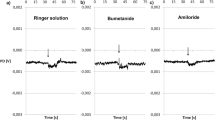Abstract
FOR the isolated, short-circuited frog skin with Ringer solution on both sides, it has been found that the active transport of sodium is equal to the current required to reduce the potential difference across the skin to zero1,2. It is also a well-known fact that the active transport of sodium depends on the oxygen supply to the skin. Francis and Pumphrey3 found that oxygen-free Ringer solution caused an irreversible disappearance of the potential difference across the skin in the course of 20–40 min.
Similar content being viewed by others
References
Ussing, H., and Zerahn, K., Acta Physiol. Scand., 23, 110 (1951).
Linderholm, H., Acta Physiol. Scand., 27, Supp. 97 (1952).
Francis, W. L., and Pumphrey, R. J., J. Exp. Biol., 10, 379 (1933).
Krogh, A., Indust. Eng. Chem. Anal. Edit., 7, 131 (1935).
Stapp, P., Proc. Soc. Exp. Biol. (N.Y.), 382, 46 (1941).
Conway, E. J., Science, 113, 270 (1951).
Author information
Authors and Affiliations
Rights and permissions
About this article
Cite this article
ZERAHN, K. Oxygen Consumption and Active Transport of Sodium in the Isolated, Short-circuited Frog Skin. Nature 177, 937–938 (1956). https://doi.org/10.1038/177937a0
Issue Date:
DOI: https://doi.org/10.1038/177937a0
- Springer Nature Limited
This article is cited by
-
Effect of Vitamin E Deficiency on Uptake of Amino-acid and Incorporation in Isolated Rabbit Diaphragm
Nature (1966)
-
Carbon Dioxide Production and Sodium Transport by the Toad Bladder
Nature (1965)
-
Oscillatorische Ph�nomene des elektrischen Potentials an der isolierten Froschhaut nach Temperaturwechsel
Pfl�gers Archiv f�r die Gesamte Physiologie des Menschen und der Tiere (1962)
-
Sodium Transport and Oxygen Consumption in the Mammalian Kidney
Nature (1961)





